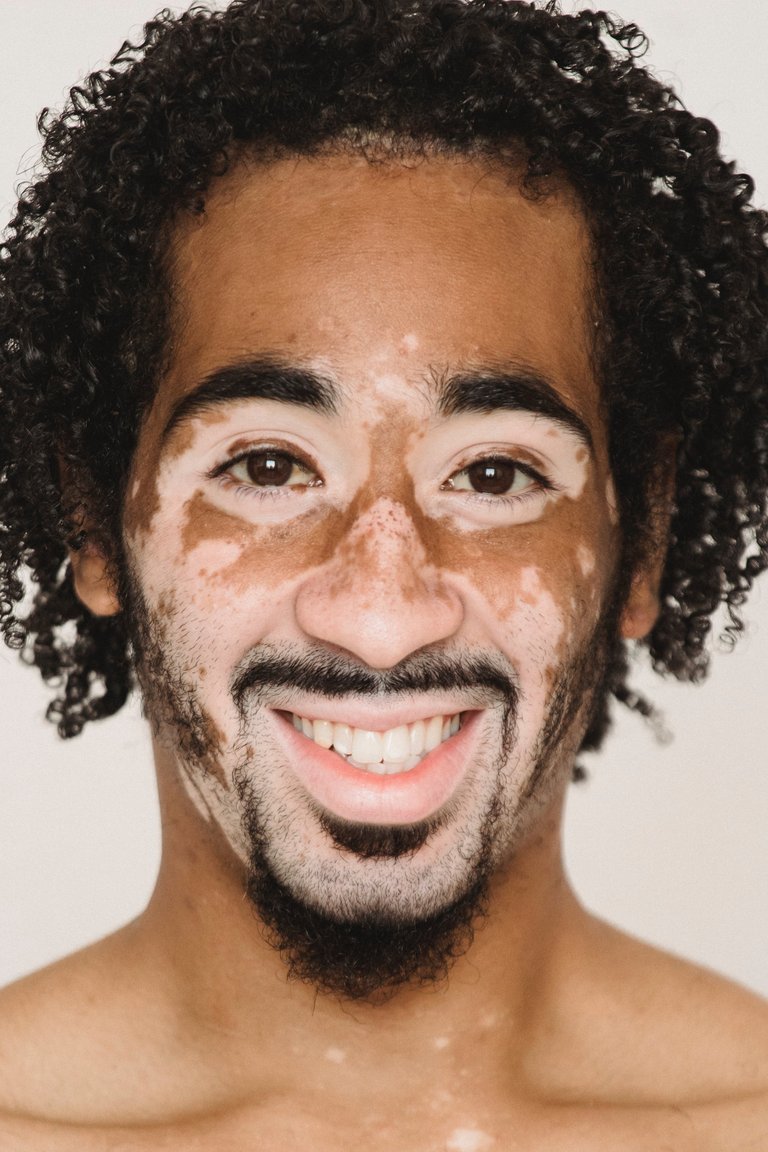I always love to pick lessons from virtually everything I see, especially when I hear about a new word, the case here however is not about a new word, it is rather about a medical condition that is new to me. I was watching a movie and I saw a young lady with a certain skin condition, I said she must be affected by fire burns, but I was wrong because I soon found out as the movie progressed that she was born that way, and her skin was like that because she suffered from vitiligo.
Vitiligo is a disease that creates loss of skin color in patches, the discolored portions of the skin will increase in size as time goes on, any part of the body can be affected by this discoloration including the mouth and the hair. Melanin is the determinant of skin and hair color, but vitiligo happens when the cells responsible for the production of melanin die or cease to function., which usually happens with the body's immune system destroying melanocytes.

pexels.com
Research is still ongoing about the causes of vitiligo, but there is an indication that around 30% of the cases are genetically inclined, which means the condition is hereditary and could be obtained from direct family members. If genetic mutation targets the cells that give skin pigment, then the symptoms of vitiligo.
While this disease can affect people of different skin types, it is more noticed amongst those with black or brown skin, it is not contagious nor life-threatening, but it could be stressful emotionally and even cause low self-esteem among others. There is a higher risk of developing vitiligo if the presence of autoimmune conditions like; Anemia, Addison's disease, lupus, rheumatoid arthritis, psoriasis, thyroid disease, and type 1 diabetes.
Usually, vitiligo begins with a few little white patches or macules that may spread gradually and take over the entire body. It most likely begins with the feet, forearms, hands, and face, but could spread to other body parts including the mucous membranes, the eyes, and inner ears. These large patches can spread and become wider, but mostly, they will remain in one place for years.

pexels.com
The amount of affected skin varies for each individual who has been diagnosed with vitiligo, some people will experience only a few pigmented regions while others will have a widespread skin color. It can start at any age but will most likely appear before the individual gets to the age of 30.
Vitiligo can be carefully categorized into these types;
Generalized form: This type of vitiligo is the most common type that exists, it causes the macules to appear in different parts of the body.
Mucosal form: This type affects the mucous membranes of the mouth, and or the genitals.
Universal form: This is a rare type of vitiligo where over 80% of the skin does not have pigment.
Trichome form: This type of vitiligo causes a bullseye with a white or colorless center, also an area of more light pigmentation, and then an area of natural skin tone.
Segmental form: This type only affects one side of the body or a specific area like the hands or the face.
Focal form: This is a rare type that has the macules developing in a small area, and they don't spread in a particular pattern within one or two years.
Although vitiligo is usually nothing to worry about, it may also cause conditions such as; eye abnormality, skin sensitivity, emotional challenges, and a predisposition to autoimmune conditions.
Experts believe that trying to treat vitiligo may not be very necessary as the condition is not harmful to the body. However, if there is a widespread of the condition all over the body that affects the patient's emotional well-being, then the healthcare provider in charge may provide a treatment option that will help to create a uniform skin tone which will be achieved either through restoring of color known as repigmentation or through the elimination of the remaining color known as depigmentation in the skin. The common available treatments are; light therapy, medications, surgery, counselling, and depigmentation therapy. Let's take a good look at them one after another.
Medications: There is no specific medication yet available to prevent vitiligo from affecting the skin, but there are drugs that could slow down the speed of pigmentation loss, help the regrowth of melanocytes, or restore skin color. The medications include; calcineurin inhibitors, corticosteroids, and topical janus kinase inhibitors.
Light therapy: This treatment will help restore skin color, light boxes, ultraviolet B (UVB lights), or medical-grade lasers will be directed at the skin for a short time, and it may require several light therapy sessions for the result to become visible.
There could be a combination of oral psoralen medication with ultraviolet A light (PUVA), the aim is to treat large skin areas with vitiligo. This treatment is more effective amongst people who have vitiligo on their neck, head, trunk, upper arms, and legs.
Depigmentation therapy: This therapy option takes out the color of your natural skin to match the areas of the skin affected by vitiligo. The therapy option uses the drug monobenzone, this medication is applied to the pigmented patches of the skin, which turns the skin white to match it up with the areas where vitiligo is present.
Counseling: Counseling or paying a visit to a mental health professional has proven to help so many people with their self-esteem, depression, and anxiety.
Surgery: Surgery is the treatment option for those who have been diagnosed with vitiligo. Options of surgical treatment include;
Skin grafts involve skin taken from one part of the body and used to cover another part.
Blister grafting involves the use of suction to create a blister on the skin, the medical expert will then take out the top of the blister and have it attached to an area where the skin has been affected by vitiligo.
Further Studies.
https://my.clevelandclinic.org/health/diseases/12419-vitiligo
https://www.nhs.uk/conditions/vitiligo/
https://www.mayoclinic.org/diseases-conditions/vitiligo/symptoms-causes/syc-20355912
https://www.healthline.com/health/skin-disorders/vitiligo-pictures#treatment
https://www.medicalnewstoday.com/articles/245081

Hi, I am Tobi a writer, speaker, relationship blogger, and lover of good music. I love making friends and learning from people. If you want to hear me speak on relationships and general life issues, you can find my YouTube channel where you can watch any episode for free, please do not forget to subscribe, friends. I sincerely appreciate every love I get from here, Kindly do well to keep them coming.
